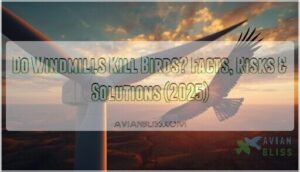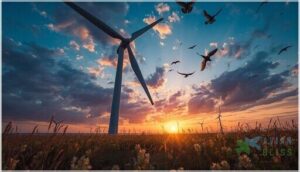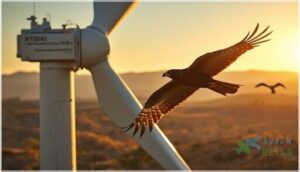This site is supported by our readers. We may earn a commission, at no cost to you, if you purchase through links.

A single wind turbine spinning against a clear sky looks like progress—clean energy replacing fossil fuels, reducing carbon emissions, saving the planet. Yet beneath those blades lies an uncomfortable truth that’s sparked fierce debate among conservationists and renewable energy advocates alike.
Wind turbines do kill birds, with estimates ranging from hundreds of thousands to over a million deaths annually in the US alone. The collision risk varies dramatically based on turbine location, species behavior, and flight patterns, making some wind farms particularly deadly for raptors and migratory birds.
Understanding this impact doesn’t mean abandoning wind energy—it means getting smarter about where we build turbines and how we design them. The evidence shows we can reduce bird fatalities by up to 80% through strategic siting, technological innovations, and collaboration between wildlife biologists and energy developers.
Table Of Contents
- Key Takeaways
- Do Windmills Kill Birds?
- How Many Birds Are Killed by Windmills?
- Which Bird Species Are Most Affected?
- How Do Windmills Compare to Other Bird Threats?
- What Strategies Reduce Bird Fatalities at Wind Farms?
- Frequently Asked Questions (FAQs)
- Do wind turbines kill birds?
- Do windmills cause bird deaths?
- How many birds are killed by wind farms a year?
- Are wind farms safe for birds?
- Does wind energy affect birds?
- Do wind turbine blades kill birds and bats?
- How do wind turbines affect bird migration routes?
- Are there alternative energy sources safer for birds?
- What measures are in place to monitor bird deaths?
- How does turbine location affect bird populations?
- Conclusion
Key Takeaways
- Wind turbines kill an estimated 681,000 to over 1 million birds annually in the US, with raptors and migratory birds facing the highest collision risks due to their flight patterns and behavioral tendencies.
- Strategic siting away from migration corridors and critical habitats, combined with technologies like painted blades and radar detection systems, can reduce bird fatalities by up to 80% at wind farms.
- While wind turbines do cause bird deaths, they account for far fewer fatalities than domestic cats (1.3-4 billion annually), building collisions (365-988 million), or fossil fuel operations (14.5 million), making them a relatively minor threat in comparison.
- The rapid expansion of wind energy could push annual bird deaths to 1.4 million by 2030, but collaboration between conservation groups, developers, and policymakers is proving that clean energy and wildlife protection can coexist through smart planning and technological innovation.
Do Windmills Kill Birds?
Yes, windmills do kill birds, and it’s a real concern that wildlife biologists and conservationists take seriously. The evidence is clear, though the numbers vary depending on how you measure them and where turbines are located.
Understanding what contributes to these collisions helps us figure out how to make wind energy safer for the birds that share our skies.
Evidence of Bird Fatalities From Wind Turbines
Wind turbines do kill birds—that’s not up for debate. Studies using trained dogs and carcass surveys have documented these bird fatalities across multiple wind facilities.
You’ll find bird deaths vary by turbine location and species patterns, with some sites experiencing higher bird collisions during migration periods. Monitoring methods have revealed both blade strikes and tower impacts, confirming wind turbines contribute measurably to bird mortality nationwide.
These deaths contribute to the estimated one million bird deaths per year in the US.
How Bird Fatality Estimates Are Calculated
Calculating bird fatalities isn’t as simple as counting bodies. You need to account for detection bias—not every carcass gets found—and carcass persistence, since scavengers remove evidence quickly.
Researchers conduct bird surveys using searcher efficiency tests and collision modeling that considers species vulnerability and flight patterns. These bird deaths are adjusted upward from raw counts, then refined through adaptive estimation as post-construction bird mortality data improves accuracy over time.
Models also incorporate collision risk assessments to estimate fatalities at wind facilities.
Factors Influencing Bird Collisions
Understanding why bird collisions happen helps you see the bigger picture beyond raw numbers. Several interconnected elements drive bird fatalities at wind turbines:
- Species vulnerability: Raptors and large soaring birds fly at rotor height more often, increasing their collision risk with wind turbine blades
- Turbine design: Taller turbines with larger rotor-swept areas create bigger collision zones
- Site selection: Turbines along migratory routes or near wetlands see higher bird mortality
- Weather impacts: Low visibility conditions reduce birds’ avoidance behavior, making collisions more likely
How Many Birds Are Killed by Windmills?
Understanding the scale of bird fatalities from wind turbines helps you put the issue into perspective. Current estimates vary based on how researchers calculate deaths, but recent projections account for the rapid expansion of wind energy across the country.
Here’s what the data tells us about annual fatalities, industry growth impacts, and how location affects collision rates.
Annual Bird Fatality Estimates
You’re probably wondering just how many birds we’re losing. The U.S. Fish and Wildlife Service estimates around 234,000 bird fatalities annually from land-based wind turbines, though detection biases and estimation underestimation push realistic projections closer to 681,000—potentially exceeding 1 million when you account for scavenger removal and survey limitations.
| Source | Annual Estimate |
|---|---|
| U.S. Fish & Wildlife Service | 234,000 birds |
| Recent Projection Models (2021) | 681,000 birds |
| Upper Range (w/ Detection Biases) | 1+ million birds |
| Per Turbine Rate | 4–18 birds/year |
| Future Projection (35% wind energy) | Up to 5 million birds |
These bird mortality figures reflect both turbine growth and our improving understanding of bird collisions’ true scope.
Impact of Wind Energy Growth on Bird Deaths
As America’s wind capacity has nearly doubled since 2012, a troubling parallel rise in bird fatalities has been observed—from 366,000 to potentially over 681,000 annually, with mortality underestimation remaining a persistent concern.
Infrastructure expansion compounds these wind turbine impacts on wildlife through:
- Habitat disruption forcing species displacement from traditional territories
- Additional bird collisions with transmission lines serving wind farms
- Future projections suggesting 1.4 million deaths by 2030 if growth continues unchecked
Bird Deaths Per Turbine and Location Variations
Where you build a wind farm matters dramatically—regional collision hotspots along coastal areas and migratory route risks show stark contrasts. Each turbine usually kills 4-18 birds annually, though habitat type and turbine size considerably influence these numbers. Location determines everything: Great Plains turbines show lower bird mortality than eastern installations, where swept zone encounters with wind turbine blades increase during migration periods.
| Region | Bird Collisions/Year | Primary Risk Factors |
|---|---|---|
| Great Plains | 4-11 per turbine | Lower migratory density |
| Coastal/Eastern U.S. | 12-18 per turbine | Migration corridors |
| Southwestern U.S. | 8-15 per turbine | Raptor territories |
| Offshore Installations | Variable data | Seabird routes |
Which Bird Species Are Most Affected?
Not all birds face the same level of risk from wind turbines. Certain species are more vulnerable due to their flight patterns, habitat preferences, and behaviors around turbine sites.
Understanding which birds are most at risk helps us target conservation efforts where they’re needed most.
Threatened and Endangered Species
When you look at species vulnerability, the picture becomes urgent. Federally threatened Marbled Murrelets face around 85 fatalities over 30 years at Washington’s Skookumchuck facility, while South Africa’s Black Harrier—with fewer than 1,300 birds remaining—loses at least 3.8 adults annually to turbines.
Bird conservation efforts show promise, though:
- California Condors have zero wind farm fatalities thanks to wildlife conservation monitoring
- Painted turbine blades reduced bird mortality by 87% in habitat disruption zones
- Shutdown protocols protect endangered species during peak activity
These mitigation successes prove that avian protection and population impacts can be managed through smart bird species strategies, though regional risks and ongoing bird conservation efforts remain essential.
Raptors and Migratory Birds
Raptors face dramatically higher collision risk factors due to ridge-soaring behavior—their fatality rate trends show 151% to 558% increases with larger turbines. Golden Eagles and Ferruginous Hawks experience population declines near facilities, while migratory birds encounter migration route disruptions along common flyways.
Behavioral responses vary: black kites avoid turbines, but griffon vultures collide frequently.
Wildlife conservation requires avian protection strategies respecting the Migratory Bird Treaty Act to reduce bird mortality through targeted mitigation strategies.
Regional Differences in Species Impact
Where you live matters—coastal concentrations create hotspots for bird mortality. You’ll find species variability across regions: Wyoming’s Glenrock Rolling Hills sites threaten raptors, while Texas corridors endanger grassland birds.
Fatality rates spike during migration peaks, raising conservation concerns that the Audubon Society highlights. Habitat displacement effects vary by location, making wildlife protection strategies regionally specific and essential for effective mitigation.
How Do Windmills Compare to Other Bird Threats?
Wind turbines do kill birds, but it’s important to put those numbers in perspective. When you compare wind energy to other human-caused threats, the picture looks quite different.
Let’s examine how wind farms stack up against powerlines, fossil fuel operations, and everyday hazards like buildings and house cats.
Powerlines and Infrastructure Impacts
When you think about threats to birds, powerlines mightn’t come to mind first, but they dwarf wind turbines in impact. Between 12 and 64 million birds die annually in the U.S. from powerline collisions and electrocution risks.
Mitigation strategies like marking wires reduce bird mortality by up to 73%, proving infrastructure research and wildlife protection efforts can make a real difference for wildlife conservation.
Bird Fatalities From Fossil Fuel Operations
While powerlines certainly take a toll, fossil fuels carry a far heavier burden. You’re looking at approximately 14.5 million bird deaths annually from coal, oil, and gas operations—mostly through habitat destruction, oil pits that trap birds, and pollution impacts.
Climate change driven by carbon emissions threatens two-thirds of North American species with extinction, dwarfing direct collision risks from any energy source.
House Cats, Buildings, and Other Risks
To put wind energy in perspective, domestic cats kill 1.3 to 4 billion birds annually in the U.S.—thousands of times more than turbines. Building collisions claim 365 to 988 million birds, while vehicle strikes account for another 89 to 340 million. Poisoning risks and powerline deaths add millions more.
While wind turbines kill hundreds of thousands of birds yearly, domestic cats kill billions—dwarfing turbines as the deadliest threat birds face
These threats dwarf wind turbine impacts, yet wildlife conservation efforts must address all sources to maintain ecological balance and support biodiversity preservation through complete wildlife protection measures.
What Strategies Reduce Bird Fatalities at Wind Farms?
Wind farms don’t have to be death traps for birds, and the good news is that we’ve learned a lot about how to make them safer. Smart planning before construction, modern technology during operation, and strong partnerships between researchers and conservationists have all proven effective at reducing fatalities.
Let’s look at the three main approaches that are making a real difference at wind farms today.
Siting and Environmental Impact Assessments
Choosing the right spot for wind turbines makes all the difference. Environmental Impact Assessments combine field surveys, radar tracking, and migration data to steer projects away from high-risk zones—think Important Bird Areas and breeding grounds. Yet siting challenges persist when project timelines trump thorough reviews.
- Avoid critical habitats where vulnerable species concentrate during nesting or migration.
- Conduct multi-season monitoring to capture how bird activity shifts throughout the year.
- Demand stronger regulatory context ensuring developers complete rigorous evaluations before breaking ground.
Measurable outcomes prove it: turbines placed in low-risk areas show dramatically lower fatality rates, protecting biodiversity while advancing clean energy.
Technological Solutions and Innovations
Beyond thoughtful placement, emerging technologies offer practical ways to protect birds. Blade painting—especially with black paint or bold red bands—cuts collisions by up to 80%. Radar detection systems and acoustic deterrents help turbines respond in real time, while turbine modulation slows rotors when birds approach. Visual patterns boost awareness, and curtailment during peak migration hours reduces bat mortality, proving eco-friendly technologies deliver measurable results.
| Technology | How It Works |
|---|---|
| Blade Painting | Black or red-banded blades improve visibility, reducing motion smear |
| Radar Detection | Sensors track birds 3–8 miles out, triggering turbine shutdown |
| Acoustic Deterrents | Emit distress calls or ultrasonic sounds to discourage approach |
| Turbine Modulation | Adjusts rotor speed when sensors detect incoming flight paths |
Research, Policy, and Conservation Collaboration
Through partnerships between conservation groups, wind developers, and federal agencies, you’ll find coordinated action protecting birds while advancing clean energy. Data sharing improves siting decisions, while policy enforcement through permits ensures compliance.
Funding support drives monitoring technologies, and transparency mechanisms track fatalities openly.
Habitat protection initiatives offset unavoidable impacts, balancing wind farms with biodiversity protection. This ecological conservation framework strengthens environmental impact management, proving bird protection and wind turbines can coexist responsibly.
Frequently Asked Questions (FAQs)
Do wind turbines kill birds?
Yes, wind turbines kill birds through collisions with rotating blades and towers. Studies document hundreds of thousands of bird fatalities annually at wind farms across North America, though mortality rates vary considerably by location.
Do windmills cause bird deaths?
Wind turbines cause bird deaths through blade collisions, with avian sensory perception limitations preventing detection. Nocturnal bird deaths occur during migration, particularly near bat mortality zones.
Audubon studies confirm turbine blade speed, wind farm acoustics, and migratory route deviation contribute to fatalities.
How many birds are killed by wind farms a year?
Current estimates place annual bird fatalities from U.S. wind turbines between 538,000 and 17 million, with projected fatalities reaching 4 million by Detection challenges and mitigation effectiveness greatly influence fatality estimate accuracy.
Are wind farms safe for birds?
Like any structure in the sky, turbines pose risks—but they’re not death traps. Strategic siting, ecofriendly technologies, and operational adjustments greatly improve bird safety, reducing turbine impact while supporting biodiversity preservation through mitigation success.
Does wind energy affect birds?
You’ll find that wind turbines do affect birds through collisions and habitat changes, though mitigation effectiveness varies. Population-level impacts remain relatively small compared to other threats, while cumulative impacts and biodiversity preservation require ongoing attention.
Do wind turbine blades kill birds and bats?
Yes, blade strike physics and motion smear effect cause bird collisions, while bat echolocation interference near turbines disrupts navigation. Migratory route disruption amplifies renewable energy’s environmental impact, though turbine noise impact on biodiversity preservation remains under study.
How do wind turbines affect bird migration routes?
Wind turbines influence migration patterns through route alteration and displacement effects. Studies show birds detour around turbines, increasing energy costs.
Strategic siting minimizes corridor usage disruptions. Proper ecosystem management balances wind energy and wildlife conservation needs effectively.
Are there alternative energy sources safer for birds?
Solar bird safety records show fewer fatalities than wind turbines, with no population-level impacts.
Hydropower bird risk involves habitat loss, while geothermal bird impact remains localized.
Renewables comparison favors solar overall.
What measures are in place to monitor bird deaths?
You’ll see carcass surveys conducted regularly around turbines, often paired with thermal cameras and acoustic monitoring for bats.
Data analysis corrects for detection biases, while reporting practices increasingly support biodiversity preservation strategies and ecological balance.
How does turbine location affect bird populations?
Where you place turbines matters tremendously. Habitat proximity, migratory routes, and land cover shape species richness and bat mortality within the swept zone.
Pre-construction assessment, biodiversity preservation strategies, ecosystem management, and ecological balance prove essential.
Conclusion
We can’t have our cake and eat it too—but we can come close. The question “do windmills kill birds“ demands honest answers and smart action.
Yes, turbines kill birds, but strategic placement, proven deterrent technologies, and ongoing research are already cutting fatalities dramatically.
You don’t have to choose between clean energy and wildlife protection. By demanding better planning and supporting innovation, you’re ensuring both can thrive together. That’s progress worth fighting for.
- https://e360.yale.edu/features/wind-turbine-bird-collision-solutions
- https://www.sustainabilitybynumbers.com/p/wind-power-bird-deaths
- https://www.cleanwisconsin.org/under-the-lens-mitigating-bird-and-bat-mortality-at-wind-farms/
- https://www.sciencedirect.com/science/article/abs/pii/S0195925525004093
- https://news.ucsc.edu/2022/11/offshore-wind-energy/









